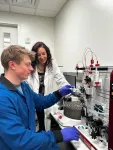(Press-News.org) University of Wyoming researchers’ study of how microscopic creatures called tardigrades survive extreme conditions has led to a major breakthrough that could eventually make life-saving treatments available to people where refrigeration isn’t possible.
Thomas Boothby, an assistant professor of molecular biology, and colleagues have shown that natural and engineered versions of tardigrade proteins can be used to stabilize an important pharmaceutical used to treat people with hemophilia and other conditions without the need for refrigeration -- even amid high temperatures and other difficult conditions. The findings are detailed today (Monday) in Scientific Reports, an online, open access journal from the publishers of Nature.
The pharmaceutical, human blood clotting Factor VIII, is an essential therapeutic used to treat genetic disease and instances of extreme bleeding. Despite being critical and effective in treating patients in these circumstances, Factor VIII has a serious shortcoming, in that it is inherently unstable. Without stabilization within a precise temperature range, Factor VIII will break down.
“In underdeveloped regions, during natural disasters, during space flight or on the battlefield, access to refrigerators and freezers, as well as ample electricity to run this infrastructure, can be in short supply. This often means that people who need access to Factor VIII do not get it,” Boothby says. “Our work provides a proof of principle that we can stabilize Factor VIII, and likely many other pharmaceuticals, in a stable, dry state at room or even elevated temperatures using proteins from tardigrades -- and, thus, provide critical live-saving medicine to everyone everywhere.”
Measuring less than half a millimeter long, tardigrades -- also known as water bears -- can survive being completely dried out; being frozen to just above absolute zero (about minus 458 degrees Fahrenheit, when all molecular motion stops); heated to more than 300 degrees Fahrenheit; irradiated several thousand times beyond what a human could withstand; and even survive the vacuum of outer space. They are able to do so, in part, by manufacturing a sugar called trehalose and a protein called CAHS D.
According to the research paper, Boothby and his colleagues fine-tuned the biophysical properties of both trehalose and CAHS D to stabilize Factor VIII, noting that CAHS D is most suitable for the treatment. The stabilization allows Factor VIII to be available in austere conditions without refrigeration, including repeated dehydration/rehydration, extreme heat and long-term dry storage.
The researchers believe the same thing can be done with other biologics -- pharmaceuticals containing or derived from living organisms -- such as vaccines, antibodies, stem cells, blood and blood products.
“This study shows that dry preservation methods can be effective in protecting biologics, offering a convenient, logistically simple and economically viable means of stabilizing life-saving medicines,” Boothby says. “This will be beneficial not only for global health initiatives in remote or developing parts of the world, but also for fostering a safe and productive space economy, which will be reliant on new technologies that break our dependence on refrigeration for the storage of medicine, food and other biomolecules.”
Boothby and other researchers hope that their discoveries can be applied to address other societal and global health issues as well, including water scarcity. For example, their work might lead to better ways of generating engineered crops that can cope with harsh environments.
END
Scientists use tardigrade proteins for human health breakthrough
2023-03-20
ELSE PRESS RELEASES FROM THIS DATE:
Researchers separate cotton from polyester in blended fabric
2023-03-20
In a new study, North Carolina State University researchers found they could separate blended cotton and polyester fabric using enzymes – nature’s tools for speeding chemical reactions. Ultimately, they hope their findings will lead to a more efficient way to recycle the fabric’s component materials, thereby reducing textile waste.
However, they also found the process need more steps if the blended fabric was dyed or treated with chemicals that increase wrinkle resistance.
“We can separate all of the cotton out of a cotton-polyester blend, meaning now we have clean polyester ...
University of Limerick, Ireland research: Back pain treatment for teens ‘ignores big picture issues’
2023-03-20
New University of Limerick, Ireland research has revealed that most treatments being offered to teenagers with persistent back pain are ‘outdated’ and ignore ‘big picture’ issues.
The study, carried out by researchers at University of Limerick along with colleagues in the UK and Australia, has shown that new approaches to tackling back pain are not being tested among teenagers.
The research, published in the European Journal of Pain, reveals that there is a lack of treatments addressing ...
Updated: AAV Treatment Recommendations
2023-03-20
AAV is a multi-organ disease, which can be complex and may vary from person to person. Types of AAV include granulomatosis with polyangiitis (GPA), microscopic polyangiitis (MPA), and eosinophilic granulomatosis with polyangiitis (EGPA). This variety can make management challenging. Comorbidities, an individual’s history, toxicities, medication availability and cost, and patient preferences should all be considered in the process of informed decision making.
EULAR first wrote recommendations ...
Real-world studies confirm effectiveness of bulevirtide to treat chronic hepatitis D
2023-03-20
Amsterdam, March 20, 2023 – In 2020, bulevirtide (BLV) was conditionally approved for treating chronic hepatitis delta (CHD), an inflammation of the liver caused by hepatitis D virus (HDV). Now real-world studies of patients treated outside of clinical trials confirm that long-term suppressive therapy with BLV monotherapy has the potential to reduce viral replication and improve liver tests of these difficult-to-treat patients for the first time in 45 years, report investigators in the Journal of Hepatology and its companion journal JHEP Reports.
Two of the studies, led by Pietro Lampertico, MD, PhD, Division of Gastroenterology and Hepatology, Foundation IRCCS Ca’ ...
Ultrafast beam-steering breakthrough at Sandia Labs
2023-03-20
ALBUQUERQUE, N.M. — In a major breakthrough in the fields of nanophotonics and ultrafast optics, a Sandia National Laboratories research team has demonstrated the ability to dynamically steer light pulses from conventional, so-called incoherent light sources.
This ability to control light using a semiconductor device could allow low-power, relatively inexpensive sources like LEDs or flashlight bulbs to replace more powerful laser beams in new technologies such as holograms, remote sensing, self-driving cars and high-speed ...
New “traffic cop” algorithm helps a drone swarm stay on task
2023-03-20
How fresh are your data? For drones searching a disaster zone or robots inspecting a building, working with the freshest data is key to locating a survivor or reporting a potential hazard. But when multiple robots simultaneously relay time-sensitive information over a wireless network, a traffic jam of data can ensue. Any information that gets through is too stale to consider as a useful, real-time report.
Now, MIT engineers may have a solution. They’ve developed a method to tailor any wireless network to handle a high load of time-sensitive data coming from multiple sources. Their new approach, ...
Nanotechnology could treat lymphedema
2023-03-20
The human body is made up of thousands of tiny lymphatic vessels that ferry white blood cells and proteins around the body, like a superhighway of the immune system. It’s remarkably efficient, but if damaged from injury or cancer treatment, the whole system starts to fail. The resulting fluid retention and swelling, called lymphedema, isn’t just uncomfortable — it’s also irreversible.
When lymphatic vessels fail, typically their ability to pump out the fluid is compromised. Georgia Institute of Technology researchers have developed a new treatment using nanoparticles that can repair lymphatic vessel pumping. Traditionally, ...
Chicago Quantum Exchange Annual Report highlights 2022 growth
2023-03-20
The Chicago Quantum Exchange (CQE) continued to expand its diverse community of quantum researchers, leaders, and institutions in 2022—launching a quantum research fellowship for undergraduates, welcoming 11 new corporate partners, and extending a regional quantum communication network to a total length of 124 miles.
These are among the successes highlighted in the CQE’s newly published annual report, which chronicles the many contributions of the consortium’s members and partners and offers a window into the region’s ...
Jellyfish size might influence their nutritional value, UBC study finds
2023-03-20
Drifting along in ocean currents, jellyfish can be both predator and prey. They eat almost anything they can capture, and follow the typical oceanic pattern of large eats small. Now a recent University of British Columbia study on these gelatinous globs suggests jellyfish may get more nutritious as they get bigger.
As jellyfish grow, their size changes largely due to the chances of prey encounter, the length and number of tentacles, and their bells (the umbrella-like part of them). As a result, smaller jellyfish eat phytoplankton, microzooplankton, and eggs, while larger jellyfish can eat all of that plus shrimp and even fish. However, ...
What Darwin couldn’t see: Expedition to uncover invisible life in Galápagos
2023-03-20
An international research team led by the Netherlands Institute of Ecology (NIOO-KNAW) is to search for invisible life in the Galápagos Islands. The diversity of bacteria and other microscopic organisms may not be evident to the naked eye, but it is essential to nature. To the islands' giant daisies, for instance: unique endemic plants that are currently under threat.
How unique and diverse is the invisible microbial life of the iconic Galápagos Islands? That's what the Galápagos Microbiome Project - a group of scientists from the Netherlands, ...








